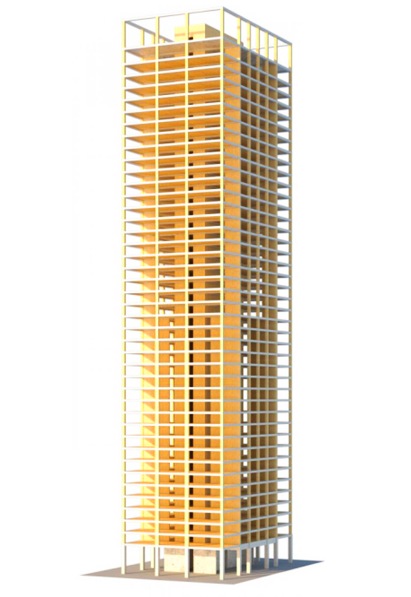In a report released today, Skidmore, Owings & Merrill discussed the results of the Timber Tower Research Project: an examination of whether a viable 400-ft, 42-story building could be created with timber framing. The prototype created by SOM incolves a combination of mass timber, concrete, and steel and was sponsored by the Softwood Lumber Board. Benchmarked against Chicago's DeWitt Chestnut Apartments—a concrete-framed facility considered revolutionary when SOM designed it in 1965—the Timber Tower represents a carbon-footprint reduction of 65% to 75%.
Tall buildings that embody conventional concrete and steel structural design usually have a higher carbon footprint than low-rise buildings, on a square-foot basis. SOM's experiment explores whether tall wood-framed buildings are feasible, justfying changes in contemporary building codes that generally limit the height of such buildings. "Building tall creates desirable urban density, but this solution helps us achieve this result with a much smaller carbon footprint," says SOM Structural and Civil Engineering Partner William F. Baker, PE, Se, FASCE, FIStructE.
SOM staff predict further developments, including possible building code adjustments, based on the research.
(http://archinect.com/news/article/74511379/som-releases-timber-tower-research-project)
Related Stories
| Oct 5, 2011
GREENBUILD 2011: Brick offers growing options for sustainable building design
Brick exteriors, interiors and landscaping options can increase sustainability that also helps earn LEED certification.
| Oct 5, 2011
GREENBUILD 2011: Roof hatch designed for energy efficiency
The cover features a specially designed EPDM finger-type gasket that ensures a positive seal with the curb to reduce air permeability and ensure energy performance.
| Oct 4, 2011
GREENBUILD 2011
Click here for the latest news and products from Greenbuild 2011, Oct. 4-7, in Toronto.
| Oct 4, 2011
GREENBUILD 2011: Methods, impacts, and opportunities in the concrete building life cycle
Researchers at the Massachusetts Institute of Technology’s (MIT) Concrete Sustainability Hub conducted a life-cycle assessment (LCA) study to evaluate and improve the environmental impact and study how the “dual use” aspect of concrete.
| Oct 4, 2011
GREENBUILD 2011: Johnsonite features sustainable products
Products include rubber flooring tiles, treads, wall bases, and more.
| Oct 4, 2011
GREENBUILD 2011: Nearly seamless highly insulated glass curtain-wall system introduced
Low insulation value reflects value of entire curtain-wall system.
| Oct 4, 2011
GREENBUILD 2011: Ready-to-use wood primer unveiled
Maintains strong UV protection, clarity even with application of lighter, natural wood tones.
| Oct 4, 2011
GREENBUILD 2011: Two new recycled glass products announced
The two collections offer both larger and smaller particulates.
| Oct 4, 2011
GREENBUILD 2011: Mythic Paint launches two new paint products
A high performance paint, and a combination paint and primer now available.
















